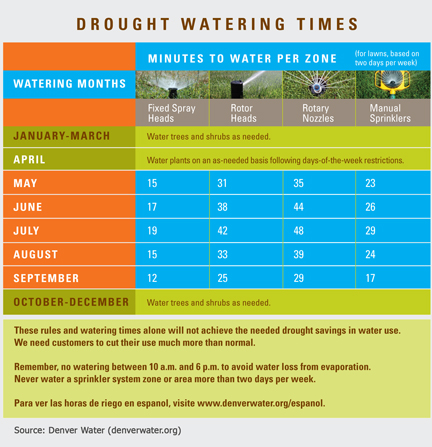by Matt Corrion
The drought of 2002 was very hard on landscaping in Colorado. Plants and lawns were stressed by the hot and dry conditions, and mandatory watering restrictions were put in place across the state. Many of us in the landscaping industry vividly remember these hard times.
Well, the drought is back. Today the USDA predicted a huge drop in corn yields, the latest is a long summer of bad drought news. Below are maps issued by the U.S. Drought Monitor from back in July of 2002 and from July of 2012. As you can see, there are many similarities and much of Colorado is once again in an “extreme drought” situation.
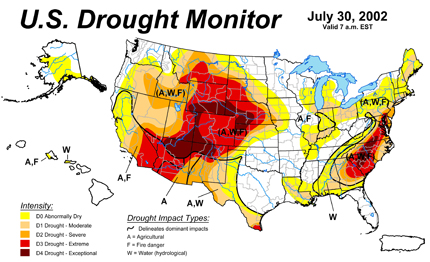
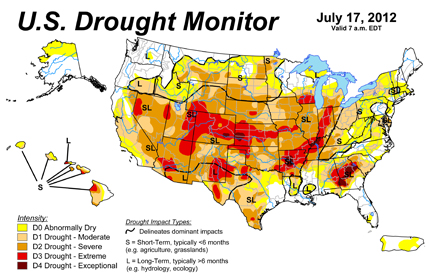
Outlook Does Not Look Good
According to the National Weather Service Climate Prediction Center, the U.S. Seasonal Drought Outlook doe not look promising, although some improvement may occur in southwestern Colorado:
Dryness and drought, exacerbated by above-normal temperatures, have been increasing both in extent and intensity across much of the central and northern U.S. Based upon the July 24 U.S. Drought Monitor, almost 64 percent of the contiguous U.S. was in drought (D1-D4), the highest such value for the U.S. Drought Monitor since its inception in 2000. The last time the lower 48 States had a comparable area of drought (based upon the monthly Palmer Drought Index) was in 1956, according to NCDC.
Across the Southwest, the odds favor an active (wet) southwest monsoon in both the 1- and 3-month precipitation outlooks. As a result, improvement is anticipated across much of Arizona, southern Utah, and southwestern Colorado as the summer monsoon continues.
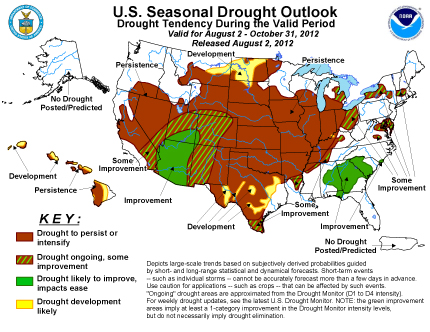
What Does this Mean for Landscaping in Colorado?
As these maps illustrate, the drought conditions that plagued Colorado in 2002 have resurfaced, and most long-term indicators point to continued drought. The good new is that there are some relatively simple changes and considerations for your landscaping to make it resilient to these conditions.
Some of the lessons we have learned and changes that can be made to your landscaping to better withstand drought include:
- Design new landscapes to be more drought tolerant in the first place. Take a more thoughtful professional approach to your landscape design and consider long term maintenance costs as well as installation costs. Consider hiring a landscape architect or design professional.
- Install the latest irrigation technologies to eliminate wasted water: smart weather based controllers, rain sensors, efficient spray nozzles and drip irrigation, to name a few.
- If lawn areas are not used for foot traffic, and are simply for aesthetics, convert these areas to masses of low growing shrubs, groundcovers, or native grass. You can achieve a similar look with plant massings at the groundplane while reducing water needs and maintenance requirements significantly.
- If you have an older irrigation system, consider having a professional do a water audit, and upgrade old nozzles to new, more efficient ones. If you are stuck with a landscape that requires a lot of water (such as large areas of bluegrass with spray irrigation) you should at least fine tune your sprinkler system. This approach is kind of like putting lipstick on a pig (since your landscape will still “require” the same amount of water to be healthy), however there are some new irrigation nozzles such as the Hunter MP Rotator that can be much more efficient at delivering water where it’s needed. At the very least, these upgrades could be a stopgap measure until the landscape can be renovated.
- Remove large areas of high water use bluegrass and lawns, and replace with native or drought tolerant plantings. A renovation of this sort will make the biggest impact by far. You can covert your landscaping from one that requires a lot of water to remain healthy, to one that requires minimal water and still looks beautiful.
So there you have it. The drought is here to stay. Colorado is a semi-arid climate that will remain dry. While tweaks and minor changes to irrigation systems can provide temporary relief, landscaping that requires a lot of water to stay healthy will always struggle in Colorado and the best approach is to install drought tolerant landscaping from the start, or renovate your landscaping to plantings that require less water.
This is the official blog of Outdoor Design Group, Colorado Landscape Architects. For more information about our business and our services, click here.
Related Posts:
by Matt Corrion
You may have heard that you can save big bucks on water and maintenance by renovating your landscaping to be more water-efficient.
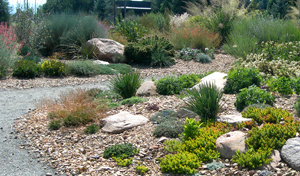
But, did you know that Cities across the country will pay you cash to do it?
As water supplies dwindle and populations rise, many municipalities are offering great incentives for reducing water use in the landscape. When property owners, businesses, or managers factor in the payback from these rebates along with the water and maintenance savings, a landscape renovation can make a lot of sense.
The 2 Main Types of Rebates
Generally speaking, incentives for reducing water use fall into two categories. The first category is paying customers to remove landscapes that have high water use and replace them with attractive low water use plantings, and the second category is to provide rebates for purchasing and installing irrigation components that reduce water use and that are more efficient than older systems.
As we have discussed in the past, the real water savings (as well as the largest rebates) come from replacing high water use lawns and landscaping, with new plantings that require less water and are more adapted to the local climate. There are many benefits to this approach- see The Top 10 Benefits of Making Landscaping More Water Efficient.
14 Specific Examples of Rebate Programs
Incentives for Removing Turf: $0.75 per square foot for single family homes and multi-family or commercial properties.
Equipment Rebates: Rebates for smart controllers, rain sensors, rotary nozzles, and equipment for removing sod and placing compost.
Additional Program Notes: Rebates of up to $150.00 are also offered for rainwater collection systems, and with the installation of a rainwater collection system the incentives double to $1.50 per square foot. Residents may also receive a $20.00 credit for attending a water efficiency class.
Equipment Rebates: Rebates for smart water controllers, weather sensors, and moisture sensors for single homes and multi-family or commercial properties.
Additional Program Notes: Rebates include 50% of the purchase price for valves, and $75.00 per drip zone installed.
Incentives for Removing Turf: $1.00 per square foot, up to $10,000 for single family homes, and up to $25,000 for multi-family or commercial properties.
Additional Program Notes: Rebates are also available for removing old hardscapes, and for seeding areas with native grasses.
Incentives for Removing Turf: $18.50 per 1,000 gallons of water saved for multi-family or commercial properties.
Equipment Rebates: Single family residential customers can receive $2.00 per efficient nozzle and $100.00 for weather-based smart controllers with rain sensors. Multi-family or commercial properties can receive $2.00 per efficient nozzle, and 25% of the cost of a smart controller.
Equipment Rebates: Single family residential customers can receive up to $1,000 for installing smart controllers and rain sensors. Multi-family or commercial properties can receive up to $5,000 for installing smart controllers and rain sensors.
Additional Program Notes: Rebates are also available for rotary nozzles, mpr spray heads, pressure reducing drip valves, and backflow prevention devices specifically made for drip systems.
Incentives for Removing Turf: $0.25 per square foot for installing drought tolerant Buffalo Grass for single family homes and multi-family or commercial properties.
Equipment Rebates: Rebates of $50.00 for moisture sensors, and 50% of the purchase price of a drip irrigation system are available for single family homes and multi-family or commercial properties.
Equipment Rebates: Single family residential customers can receive up to $550.00 for installing smart controllers, rain sensors, and rotary nozzles. Multi-family or commercial properties can receive up to $3,550.00 for installing smart controllers, rain sensors, and rotary nozzles.
Additional Program Notes: Rotary nozzle rebates are available for up to $200.00 for single family residential, and up to $2,000 for multi-family or commercial properties. Rebates are available for 50% of the purchase price of smart controllers and rain sensors.
Incentives for Removing Turf: Rebates of up to $1,650 are available for single family homes and multi-family or commercial properties.
Equipment Rebates: Rebates of up to $250.00 are available for installing smart controllers.
Incentives for Removing Turf: Up to $3,000 for single family homes and multi-family or commercial properties.
Equipment Rebates: Single family residential customers can receive up to $250.00 for installing smart controllers. Multi-family or commercial properties can receive up to $1,250.00 for installing smart controllers.
Additional Program Notes: A minimum area of 1,000 square feet of turf must be removed to qualify for turf removal incentives.
Incentives for Removing Turf: $1.50 to $1.00 per square foot, up to $300,000 for single family and multi-family or commercial properties.
Equipment Rebates: 50% of the cost of smart controllers, and $25.00 for rain sensors for single family and multi-family or commercial properties.
Incentives for Removing Turf: $1.50 per square foot up to $3,000 for single family homes, and $1.50 per square foot up to $9,000 for multi-family or commercial properties.
Equipment Rebates: Single family residential customers can receive up to $400.00 for installing smart controllers. Multi-family or commercial properties can receive $25.00 per station up to 68 stations ($1,700) for installing a smart controller.
Additional Program Notes: Rebates of $0.50 for every gallon of storage capacity up to 400 gallons are offered for rainwater collection systems.
Incentives for Removing Turf: $0.75 per square foot up to $2,000 is available for for single family homes, and $0.75 per square foot up to $20,000 is available for multi-family or commercial properties.
Equipment Rebates: Rebates are available for smart controllers, rain sensors, rotary nozzles, and dedicated landscape meters.
Additional Program Notes: Rebates of $1.50 per square foot up to $30,000 are also available for commercial properties through a “cost sharing areas” program.
Equipment Rebates: Single family residential customers can receive up to $375.00 in equipment rebates. Multi-family properties can receive up to $500.00 for new equipment.
Additional Program Notes: Rain water harvesting rebates of up to $5,000 are available for no-pressurized or pressurized systems.
Incentives for Removing Turf: Rebates of up to $400.00 are available for reducing water bill for single family homes and multi-family or commercial properties.
Equipment Rebates: Rebates of up to $3,200 are available for installing smart controllers, rain sensors, and rotary nozzles.
Additional Program Notes: Incentives are offered for capping irrigation zones and/or converting existing irrigation systems to drip.
These incentive and rebate programs are typically limited to a maximum allowable rebate amount based on the area of the project, and the purchase price of the irrigation components. Many of the programs also are only available on a first come first serve basis. With limited funding many municipalities exhaust their funds in the first few months of the year. Other program requirements include selecting plants from specific drought tolerant or native plant lists, percentage of plant area coverage, and the make and model of irrigation components.
Because of the complexity of the projects and the paperwork involved, it may make sense to have a landscape architect assist you for a moderate fee. These professional consultants can prepare any plans that are needed, submit applications, gain approval from local building departments and HOA’s, and maximize the potential rebate amount you will get back.
In addition, most states require a licensed landscape architect to prepare plans for any major renovation on a commercial or larger residential property. The fees for these services are often offset by the savings that come from having a good plan that can be accurately bid and installed by contractors.
So, if you are looking to make your property more sustainable, update it’s image, and save on maintenance and water, look into what programs may be available in your area.
This is the official blog of Outdoor Design Group, Colorado Landscape Architects. For more information about our business and our services, click here.
Related Posts:
by Matt Corrion
It’s good for the environment.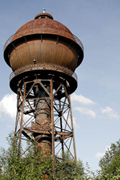
It can save you money on water bills and maintenance.
There are many reasons for you to renovate your landscaping to save water. But why would a water provider or utility want you to use less of what they provide- water?
Since we work with customers to reduce their water-use, we hear this question quite often. It does seem counter intuitive: Why would someone who is in the business of selling water want you to use less of it- in many cases offering rebates and incentives to do so?
Can you imagine a Walmart employee standing outside of the store offering to give you $20 back, if you spent LESS money inside the store?
There are a few key reasons why water conservation is encouraged by water providers:
First, water demand will always continue to increase, regardless of how much our water use is reduced. Population growth and land development put a great deal of strain on our water supply and the water delivery system.
Because the demand will always be there, it is in the water provider’s best interest to slow the rate of growth as much as possible. There are large systems for treating, storing, and delivering water that need constant expansion and repair.
Secondly, water conservation is already built into the billing system. Most water suppliers now use a conservation-oriented “tiered” rate structure. These rate structures charge a base rate regardless of how much water is used, and separate rates for the levels of water that is actually consumed.
Finally, water utilities often consist of complex public/private partnerships, so there are environmental and public health considerations that are just as important as profit. Would we really want our water system to be based totally on how much revenue and profit could be generated?
When considering the public good in terms of water conservation, there are numerous considerations: Preparedness for droughts; the health of our rivers, lakes, and streams, and aquifers; impacts to other cities and states “downstream”; and even national security.
This is the official blog of Outdoor Design Group, Colorado Landscape Architects. For more information about our business and our services, click here.
Related Posts:
by Matt Corrion
Thanks to Barbara Landrith at CLCA for sharing this great article (M2 Equitybites), excerpts from which follow:
Water and wastewater services provider California American Water, a subsidiary of American Water, stated on Thursday that the company and the Monterey Peninsula Water Management District will be offering more rebates for installation of water-saving appliances and water-wise landscaping, commencing this month.
Residents can earn rebates for removing lawn and replacing it with low water use plants, permeable surfaces or synthetic turf. This programme now offers $1.25 per square foot of lawn removed and replaced with low water use plants or permeable surfaces up to 5,000 square feet (an increase from 2,000 square feet). Lawn replaced with synthetic turf qualifies for an additional rebate of $2.00 per square foot up to 2,000 square feet, bringing the maximum rebate amount to more than $10,000.
My Thoughts: Those are pretty substantial rebates. The amounts available are higher than I have seen in the past, and would be more than enough incentive for homeowners to consider renovating their landscaping to save water.
Unfortunately, the only landscape related rebates mentioned for commercial businesses are for graywater irrigation systems. While I applaud those efforts, a much greater opportunity for water savings for commercial properties is in offering substantial rebates to replace high water-use landscaping with more water-wise landscaping.
This is the official blog of Outdoor Design Group, Colorado Landscape Architects. For more information about our business and our services, click here.
Related Posts:
